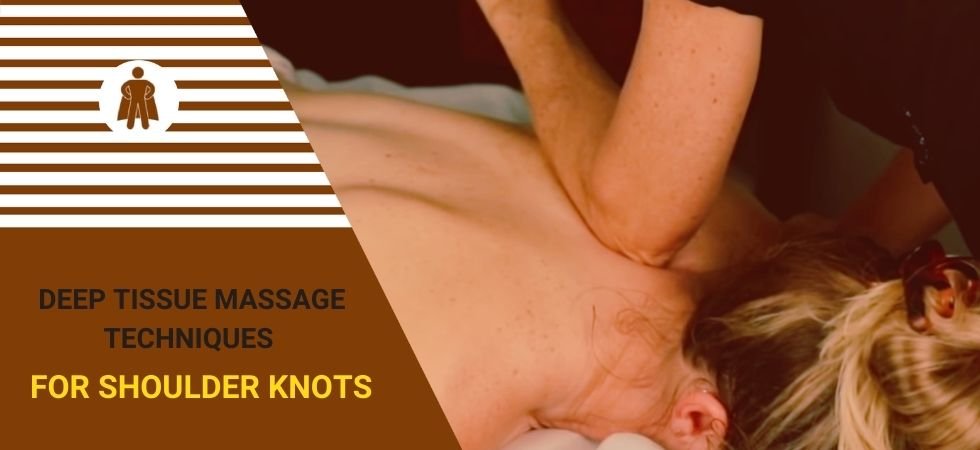Deep Tissue Massage Techniques for Shoulder Knots
Contents
- 1 What Are Shoulder Knots
- 2 Deep Tissue Massage Overview
- 3 Deep Tissue Massage Techniques for Shoulder Knots
- 4 How Deep Tissue Massage Helps Shoulder Knots
- 5 When to Opt for Deep Tissue Massage
- 6 Maximizing the Effects of Deep Tissue Massage
- 7 Finding a Professional Massage Therapist
- 8 Using Shoulder Massagers at Home: An Effective Alternative
- 9 Conclusion
In today's fast-paced world, our bodies often bear the brunt of our busy schedules, leading to a variety of discomforts and ailments. Among these, shoulder knots, also known as myofascial trigger points, have become an all-too-common problem for many individuals.
These knots, characterized by tight and painful muscle fibers, can significantly limit your range of motion and impair your overall quality of life. One effective way to alleviate the discomfort associated with shoulder knots is through deep tissue massage.
Deep tissue massage is a specific type of massage therapy that focuses on the deeper layers of muscles and connective tissue. It is especially beneficial for chronic aches and pains, like the stiff neck, tightness in the lower back, and sore shoulders often associated with muscle knots.
This article will delve into the intricacies of shoulder knots and deep tissue massage, highlighting the various techniques used in this therapeutic practice to untangle these bothersome knots.
What Are Shoulder Knots
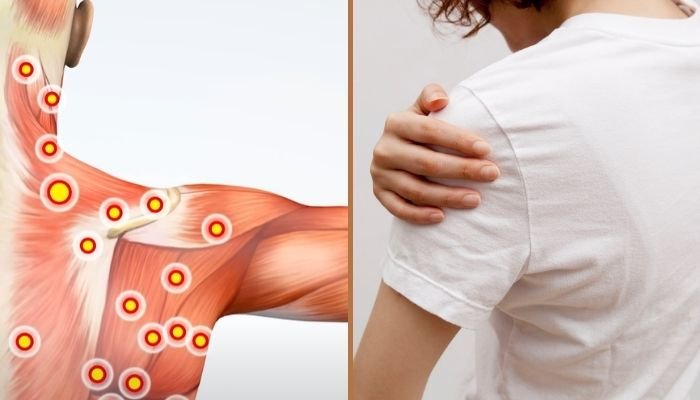
Shoulder knots, or myofascial trigger points, are hard, sensitive areas of muscle that tighten and contract even when the muscle is at rest. These palpable nodules form as a result of muscle fibers that have not properly released after contracting. Essentially, they are points in your muscle where tension and stress have built up, creating a tight, often painful, spot.
Various factors contribute to the formation of these knots. Poor posture, particularly during prolonged periods of sitting or standing, can lead to muscle imbalances and subsequent knot formation. Overuse of a specific muscle group, as seen in certain sports or occupations, can also cause knots to develop. Stress and anxiety, which can cause muscle tension and tightness, are other common culprits.
Symptoms of shoulder knots vary but typically include localized pain, muscle tightness, and restricted range of motion. The pain can be persistent and dull or it can flare up when the knot is touched or when the muscle is in use. It's also possible for these knots to cause referred pain, which is pain felt in a different part of the body.
Shoulder knots can affect anyone, regardless of age or physical condition. Left untreated, these knots can lead to more significant issues such as chronic pain, limited mobility, or tension headaches. Understanding their causes and symptoms is the first step towards effective treatment and prevention, where deep tissue massage plays a vital role.
Deep Tissue Massage Overview
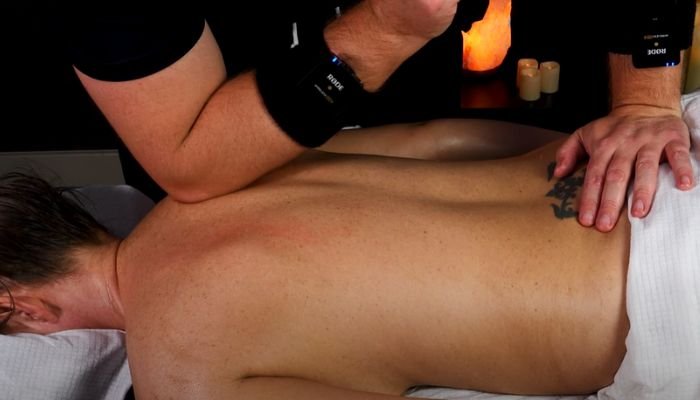
Deep tissue massage is a form of massage therapy that primarily targets the deeper layers of muscles and fascia (the connective tissue surrounding muscles). Its primary aim is to relieve tension in the body through slow, deliberate strokes and firm pressure on contracted areas.
The process involves manipulating the sub-layers of muscle and fascia, breaking down adhesions (bands of painful, rigid tissue) to restore normal movement and reduce pain.
This massage technique is commonly used to treat musculoskeletal issues, such as strains and sports injuries, by facilitating the healing process and increasing blood flow to the affected areas.
However, its benefits extend beyond physical relief. Deep tissue massage can also contribute to stress reduction and enhanced relaxation, as it stimulates the body's production of oxytocin and serotonin – hormones known to boost mood and promote a sense of relaxation and well-being.
The relevance of deep tissue massage in treating shoulder knots cannot be overstated. By applying sustained pressure using slow, deep strokes, the therapist targets the inner layers of muscles and connective tissue.
This helps to break down knots and relieve tension, leading to a reduction in pain and an increase in range of motion. The upcoming section provides a closer look at specific deep tissue massage techniques for dealing with shoulder knots.
Deep Tissue Massage Techniques for Shoulder Knots
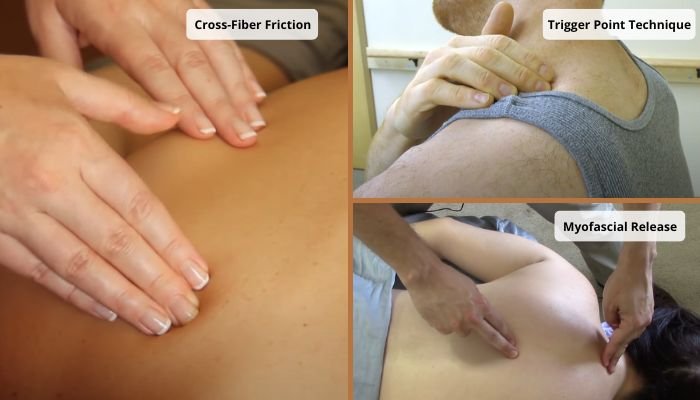
When it comes to relieving shoulder knots, deep tissue massage techniques can be particularly effective. Here are some techniques that massage therapists often use to address this issue:
Cross-Fiber Friction
This technique involves applying pressure across the grain of the muscle to break down adhesions and realign tissue fibers. In the case of shoulder knots, the therapist would apply firm pressure directly to the knot and move back and forth across it. This motion helps break down the knot and restore normal muscle function.
Trigger Point Technique
Trigger points, or knots, can be released by applying direct pressure to the area. The therapist uses their fingers, knuckles, or an elbow to apply sustained pressure to the knot. This pressure helps to "release" the knot and relieve pain. This process might be repeated several times during a session, depending on the severity and number of knots.
Myofascial Release
Myofascial release is a technique where the therapist gently massages the myofascia (connective tissue around the muscles) to release tension. This is done by stretching and kneading the fascia to loosen it and release any tightness. Myofascial release can be particularly helpful for shoulder knots as it targets the tissue surrounding the muscle where the knot is located.
Each of these techniques should be performed by a trained professional to avoid injury.
Before a session begins, the therapist should understand your pain level, medical history, and comfort level to ensure a safe and effective massage. It's also important to communicate with your therapist during the massage if you feel any discomfort or pain.
Precautions need to be taken during deep tissue massage, especially if you have certain medical conditions such as blood clots, cancer, fractures, rheumatoid arthritis, osteoporosis, or if you are pregnant. It's always a good idea to consult with your doctor before starting any new therapeutic practice if you have chronic medical conditions.
How Deep Tissue Massage Helps Shoulder Knots
The relief and healing properties of deep tissue massage are grounded in science. When the therapist applies pressure to the muscle knots, a process known as ischemic compression occurs. This means the blood flow to the knot is briefly cut off. When the pressure is released, a rush of fresh blood floods the knot, delivering oxygen and nutrients that help to heal the muscle fibers.
Deep tissue massage also helps to break down adhesions. Adhesions are bands of painful, rigid tissue that can form as a result of muscle strain or injury. They can disrupt circulation, cause pain, and limit your range of motion. The firm pressure and slow strokes of deep tissue massage help to 'break up' these adhesions, thereby relieving pain and restoring normal movement.
Moreover, this type of massage has the added benefit of stimulating the lymphatic system, the body's natural defense against toxins. As the massage works to relax the muscles and fascia, the lymphatic system works more efficiently to remove waste products from the body.
The immediate benefits of deep tissue massage for shoulder knots include relief from pain, increased range of motion, and improved muscle flexibility. However, the advantages of this therapy extend beyond the immediate.
Regular deep tissue massages can help prevent new knots from forming by maintaining healthy muscle tissues, reducing stress, and promoting overall muscle relaxation. They can also contribute to improved posture, better sleep, and enhanced overall wellbeing.
It's important to note that while you may experience some soreness after a deep tissue massage, this should subside within a day or two. This is a normal reaction as your muscles adjust and heal. If the pain persists or is severe, it's crucial to consult with your healthcare provider or massage therapist.
When to Opt for Deep Tissue Massage

Deep tissue massage can be highly effective if you are dealing with chronic pain, particularly in the shoulders, lower back, neck, or any muscle group that frequently experiences tension. I
t's also a recommended approach for those with shoulder knots resulting from occupational stress, poor posture, or sports-related muscle strain. Regular sessions can help maintain muscle health, reduce the formation of new knots, and promote overall wellbeing.
However, it is crucial to note that deep tissue massage may not be suitable for everyone. For individuals with certain health conditions such as inflammatory diseases, blood clotting disorders, or certain forms of cancer, deep tissue massage could potentially cause harm.
In cases of acute injuries or inflammation, lighter massage techniques or other treatment options might be preferable until the acute phase has passed.
Pregnant individuals should also be cautious, as deep pressure might not be safe, particularly in certain stages of pregnancy. A specialized form of massage, known as prenatal massage, is usually a safer option.
Before opting for a deep tissue massage, it's always advisable to consult with a healthcare provider, especially if you have underlying health conditions. A professional will be able to provide advice tailored to your specific health needs and circumstances. It's also critical to communicate openly with your massage therapist about your medical history and any discomfort or concerns during the session.
Maximizing the Effects of Deep Tissue Massage
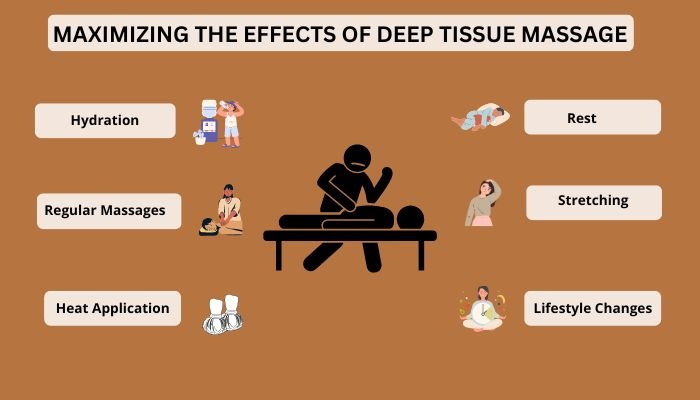
While receiving a deep tissue massage from a trained professional is the first step towards relieving shoulder knots, there are also several strategies to enhance the effects of your massage and prolong the benefits.
Remember, it's crucial to communicate openly with your massage therapist to make sure the massage pressure is comfortable and the techniques are effective for you. Aftercare is also key in ensuring you maximize the benefits and promote long-term relief from shoulder knots.
Finding a Professional Massage Therapist

To ensure you're getting the most from your deep tissue massage, it's essential to find a qualified and experienced massage therapist. Here are some tips to help you find the right professional:
Certifications and Qualifications: Check that the therapist is certified by a recognized organization and has completed the necessary training to practice massage therapy. These qualifications should be clearly listed on their website or available upon request.
Specialization: Look for a therapist who specializes in deep tissue massage, especially if you're seeking treatment for specific issues like shoulder knots. Therapists with this specialization will have a deeper understanding of the techniques and strategies that are most effective in treating your condition.
Experience: While qualifications are important, so too is experience. Therapists with several years of experience will have had the opportunity to hone their skills and techniques.
Communication: A good therapist will take the time to discuss your health history, understand your needs, and explain the techniques they plan to use. They should also be receptive to your feedback during the massage, adjusting their pressure and techniques to suit your comfort levels.
Reviews and Recommendations: Read reviews or get recommendations from friends or family members. Personal experiences can give you valuable insights into what you can expect from the therapist.
Remember, effective deep tissue massage therapy involves more than just technical skills. The therapist's ability to establish a comfortable, trusting environment can significantly influence the effectiveness of the treatment. Therefore, it's essential to find someone who is not only competent and experienced but also someone with whom you feel comfortable and at ease.
Using Shoulder Massagers at Home: An Effective Alternative

While professional deep tissue massages can be highly effective in treating shoulder knots, sometimes it might not be feasible to visit a massage therapist regularly. In such cases, investing in a home shoulder massager can serve as a beneficial alternative.
Home shoulder massagers are designed to mimic the hands of a professional masseuse, delivering deep kneading and Shiatsu-style massages to the comfort of your home. Here's what you should know about using them:
Types of Shoulder Massagers
Shoulder massagers come in various types - handheld massagers, belt massagers, chair pads, and massage pillows. Handheld massagers provide a good range of motion and can reach hard-to-reach areas, while belt massagers can be wrapped around your body, offering a hands-free experience. Massage pillows and chair pads can be excellent for a more passive massage experience.
Usage
Using a home massager is typically straightforward. After positioning the device on your shoulder, you simply switch it on, adjust the settings to your liking, and let the device work on your knots. Most massagers offer different speed settings and massage modes, allowing you to customize the massage to your needs.
Benefits
Home massagers provide the convenience of a massage at any time that suits you. They can effectively work on muscle knots by applying consistent pressure and heat, if available, to help ease muscle tension. While they might not entirely replicate the experience and skill of a professional massage therapist, they can provide significant relief and relaxation.
Considerations
While convenient, home massagers should be used with caution. Never use a massager on bare skin, wounds, or inflamed areas. Always start on a lower setting and gradually increase intensity to ensure comfort. Also, it's essential not to use the massager for extended periods to avoid overstimulating the muscles, which could lead to injury.
Remember, while home shoulder massagers can provide significant relief from shoulder knots, they shouldn't replace professional medical advice or treatment for chronic or severe muscle pain. Always consult with a healthcare provider if you're experiencing persistent pain or discomfort.
Conclusion
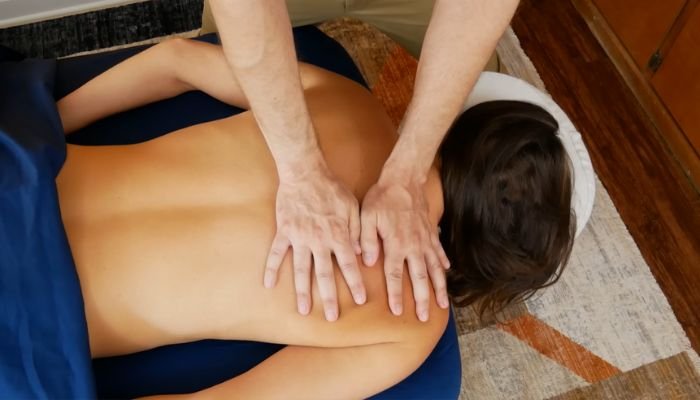
Shoulder knots, while common, can significantly impact your quality of life by causing pain and limiting your mobility. Deep tissue massage has emerged as a highly effective way to alleviate the discomfort associated with these knots. By applying slow, deliberate strokes and firm pressure, deep tissue massage can break down knots, relieve muscle tension, and restore normal muscle function.
The benefits of deep tissue massage extend beyond the immediate relief of pain. Regular sessions can maintain muscle health, prevent the formation of new knots, and contribute to improved overall wellbeing. It's essential, however, to consult with a healthcare provider before starting this therapy, especially if you have chronic medical conditions.
When paired with lifestyle modifications like regular movement, proper hydration, and ergonomic changes to your work setup, deep tissue massage can be a valuable tool in your wellness toolkit. By choosing a qualified and experienced massage therapist, you can ensure you're getting the most from your sessions and taking a proactive step toward better health and wellbeing.

